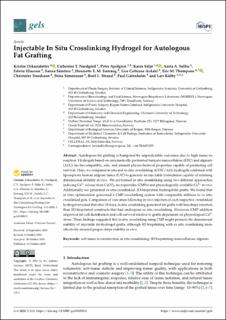Injectable In Situ Crosslinking Hydrogel for Autologous Fat Grafting
Oskarsdotter, Kristin; Nordgård, Catherine Taylor; Apelgren, Peter; Säljö, Karin; Solbu, Anita Akbarzadeh; Eliasson, Edwin; Sämfors, Sanna; Sætrang, Henriette Elisabeth Myhr; Asdahl, Lise Cathrine; Thompson, Eric Malcolm; Troedsson, Christofer; Simonsson, Stina; Strand, Berit Løkensgard; Gatenholm, Paul; Kölby, Lars
Journal article, Peer reviewed
Published version

View/
Date
2023Metadata
Show full item recordCollections
- Department of Biological Sciences [2225]
- Registrations from Cristin [9688]
Abstract
Autologous fat grafting is hampered by unpredictable outcomes due to high tissue resorption. Hydrogels based on enzymatically pretreated tunicate nanocellulose (ETC) and alginate (ALG) are biocompatible, safe, and present physiochemical properties capable of promoting cell survival. Here, we compared in situ and ex situ crosslinking of ETC/ALG hydrogels combined with lipoaspirate human adipose tissue (LAT) to generate an injectable formulation capable of retaining dimensional stability in vivo. We performed in situ crosslinking using two different approaches; inducing Ca2+ release from CaCO3 microparticles (CMPs) and physiologically available Ca2+ in vivo. Additionally, we generated ex situ-crosslinked, 3D-bioprinted hydrogel-fat grafts. We found that in vitro optimization generated a CMP-crosslinking system with comparable stiffness to ex situ-crosslinked gels. Comparison of outcomes following in vivo injection of each respective crosslinked hydrogel revealed that after 30 days, in situ crosslinking generated fat grafts with less shape retention than 3D-bioprinted constructs that had undergone ex situ crosslinking. However, CMP addition improved fat-cell distribution and cell survival relative to grafts dependent on physiological Ca2+ alone. These findings suggested that in situ crosslinking using CMP might promote the dimensional stability of injectable fat-hydrogel grafts, although 3D bioprinting with ex situ crosslinking more effectively ensured proper shape stability in vivo.
